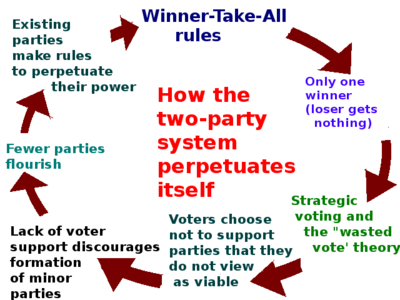Contents
The plurality vote: must it lead to a 2-party system?
A team project for MA279, Fall 2013
Team members: Bennett Marsh, Edwin Baeza, Kenneth Brown, Amberlee Carl
Introduction
It is a well known phenomenon that plurality elections tend to support 2-party political systems. This observation is generally credited to sociologist Maurice Duverger, who studied it in the 1950s and 1960s. Though this idea is supported by many real-world examples, is it necessarily true that all plurality systems must lead to 2 dominant political parties? And if not, what are the other factors that could influence the development of the political party structure?
To answer these questions, we first answer the question of what one means by a "2-party system". For example, in the United States, most people would agree that there is currently a 2-party system, with the 2 dominant parties being the Republicans and Democrats. However, there do exist other parties, such as the Libertarian and Green parties. The standard definition is that a 2-party system is one in which nearly all of the elected officials belong to one of 2 parties, and these 2 parties control a large majority of the government's power. This is a fairly loose definition, but in most cases it is relatively clear whether or not a certain political system should be classified as a "2-party system".
Plurality Voting
Plurality voting systems are used to determine winners in elections based on single-member districts (i.e., candidates run for specific seats, and each seat may only have one winner). These come in two main varieties: the most popular, also known as "first-past-the-post", is used in most United States political elections. In this method, the candidate who receives more votes than any other candidate in a single round of voting is declared the winner (does not necessarily have to receive an absolute majority of votes). The other, known as "runoff" voting, consists of two separate rounds of voting. If one candidate has an absolute majority after the first round, he is declared the winner. Otherwise, the two candidates with the most votes compete head-to-head in a second round. In this way, the winner always receives an absolute majority.
Duverger's law applies to any type of plurality election. Plurality voting can be contrasted with other methods such as "proportional representation", in which the number of seats a certain party/group receives is proportional to the number of votes received (see below). Since candidates to not run for specific seats, these methods can help avoid the collapse into a two-party system, as there is more incentive for voters to vote for minor parties.
Duverger's Law
Duverger's Law, attributed by Maurice Duverger, states that in a system which a plurality vote takes place, with each voter getting a single vote for one candidate, and only a single candidate winning the election, a two-party system will emerge. There are two main reasons for this. They are tactical voting and fusion of minor parties. Tactical voting is when voters tend to change their vote from their top choice candidate to a vote for a stronger party so that their vote is not "wasted". For example, let us suppose that there are 100 voters: 40 prefer an extreme candidate, while the remaining 60 are split 40/20 between two moderate candidates, A and B, respectively. With each voter voting for their top choice, the extreme candidate will win. However, let's assume that the 20 moderate voters would prefer the other moderate candidate over the more extreme one. If these twenty switch their vote from B to A, A candidate wins. If not, the extreme candidate wins, and their vote was "wasted". This will ultimately lead to the collapse of the weaker moderate party, as voters desert this party in order to vote for one with a stronger chance of winning, and into a two-party system. Fusion of parties works similarly, where over time, two or more different parties will come together, combining and compromising between their ideals, in order to gain voters from both parties. As this new party developed, the parties coming together are abandoned, again leading to a two-party system.
The below diagram illustrates how Plurality elections tend to promote 2-party systems (from wikipedia.org)
Examples of this can be seen all over the world. The United States is an excellent example. Over the course of history, the U.S. has been a two-party system, with a third party candidate very rarely winning an election. Britain and Spain are also good examples. While they have some legislative participation by small, minor parties, the majority of policymakers are from one of the two major parties in each respective country. Plurality voting leading to a two party system can also be seen in Malta and Australia.
Counterexamples
- Counterexamples - there exist plurality systems in which there are more than 2 dominant parties
- Converse is not true: 2 party systems may arise even without a plurality election
- Ways of avoiding the collapse into a 2-party system
- Modifications to the standard plurality system
- How a third party can become prominent when 2 dominant parties are already established
- Third parties can exploit weaknesses/mistakes of some major party
- Usually only happens in times of political/social turmoil - e.g. the Civil War
References
[1] http://janda.org/c24/Readings/Duverger/Duverger.htm - An original paper by Duverger describing his law


